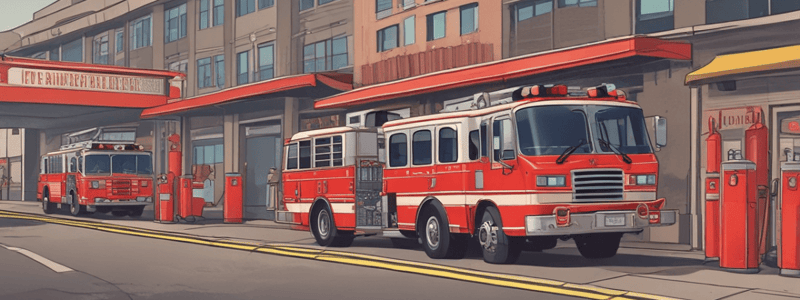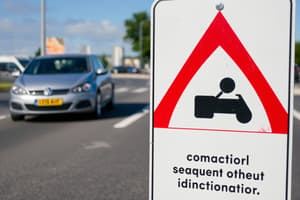Podcast
Questions and Answers
When parking apparatus, what should drivers avoid doing?
When parking apparatus, what should drivers avoid doing?
- Positioning in a building collapse area
- Positioning near a building entrance
- Positioning near a storm grate
- All of the above (correct)
What should drivers consider when positioning apparatus?
What should drivers consider when positioning apparatus?
- Wind direction and speed
- Only overhead power lines
- Wind direction and power lines
- Wind direction as a factor (correct)
Why should drivers use wheel chocks when positioning apparatus?
Why should drivers use wheel chocks when positioning apparatus?
- To improve overhead clearance
- To ensure better visibility
- To ensure proper parking
- To secure the vehicle from rolling (correct)
What should drivers do when exiting the vehicle from the curbside?
What should drivers do when exiting the vehicle from the curbside?
During medical incidents, what should personnel do to assist the incoming Toronto EMS unit?
During medical incidents, what should personnel do to assist the incoming Toronto EMS unit?
Why should sufficient space be left between the Toronto EMS vehicle and TFS apparatus?
Why should sufficient space be left between the Toronto EMS vehicle and TFS apparatus?
What should drivers do when parking specialized apparatus and support units?
What should drivers do when parking specialized apparatus and support units?
Why should drivers shut down headlights and forward-facing white warning lights?
Why should drivers shut down headlights and forward-facing white warning lights?
Flashcards are hidden until you start studying
Study Notes
All Incidents
- Avoid parking apparatus on/over maintenance covers, storm grates, or too close to curb side fixed objects, building entrances, and exits.
- Ensure apparatus are not too close together, restricting personnel and equipment movement.
- Avoid positioning in building "collapse areas" or on "soft" surfaces.
- Beware of speed bumps, potholes, and uneven ground when parking and removing equipment.
- Look out for potential hazards before stepping out of the apparatus.
- Keep crew cab and compartment doors closed when not in use.
Safe Positioning
- Look for overhead hazards like power lines, trees, and signs before positioning apparatus.
- Consider wind direction when positioning apparatus.
- Use wheel chocks to secure apparatus.
- Position apparatus to allow personnel to exit from the curbside.
- Position apparatus to allow for easy relocation due to unforeseen danger or reassignment.
- Turn off headlights and forward-facing white warning lights unless required to illuminate the working area.
Medical Incidents
- Assist incoming Toronto EMS units by leaving clear access as close as possible to the incident.
- Leave sufficient space between the Toronto EMS vehicle and TFS apparatus.
- Allow sufficient space to provide greater protection for personnel when working at the rear of an ambulance.
- Never pull close to an EMS unit in case the apparatus is rear-ended.
- Leave ample room for the EMS unit to safely clear the area without backing up.
Fire Incidents
- Position Pumpers to allow for proper Aerial set up, even if there are no visible signs of fire.
- Ensure easy water supply connection if necessary.
- Position Pumpers to direct the pump panel towards the fire.
Studying That Suits You
Use AI to generate personalized quizzes and flashcards to suit your learning preferences.




